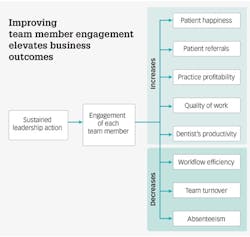How to get a handle on the right attitude: Bringing new technologies into the practice
Gary Kaye, DDS, FAGD
In my last column I brought up the concept of the "iceberg illusion" when integrating new technologies into the dental workplace. It is critical that the right attitudes liew below the surface. They must be recognized, understood, and encouraged. These "underwater" elements will be able to drive the entire office team to overcome the challenges that new technologies present. The dentist must lead and maintain an environment where these right attitudes are present and consistent across the team.
The key attitudes
Like anything we do in our practices, integration requires a lot of hard work in order to be successful. It's not uncommon for a procedure to be demonstrated so effectively that it gives the illusion that it is easy to do. We have to keep in mind that the presenter may be much more experienced. I'm convinced that fully mastering any technology relies on hard work and perseverance, just as mastering a procedure does.
Mastering a procedure requires repetition and a deep understanding of technique. This happens only by practice, study, and trial and error. A simple two-surface restoration in dental school took me a number of hours to complete on my first patient, and a lot of that time was devoted to placing the rubber dam. Of course, it now takes me only a few seconds to place a dam, but that only changed with practice. The same is true for using a digital scanner. I have observed, both in our practices and at NYCDD, where we train dentists and assistants in digital dentistry, that there is no substitute for persistence in mastering these skills.
Learning every facet of something new requires a special level of dedication and discipline. No matter the level of IT competency, it is exceedingly important that those in the practice take the time to master the digital workflows and the basic operations of the software and hardware involved. The good news is that most devices are being designed with the intention of being user-friendly for the average practice.
It is inevitable that along the path of mastering digital dentistry there will be bumps in the road. Our mantra at NYCDD is that we "plan it, do it, and then fix it." It is our way of overcoming setbacks and getting to the next level.
Pulling in the team
Success in digital dentistry requires engaged employees. Employee engagement has been linked to successful outcomes in all kinds of enterprises, and it probably has an even greater effect in a dental practice where there is such a high level of employee-patient interaction.
Leadership and team engagement
As the practice owner or manager, you have a tremendous influence on the level of engagement of team members. This engagement relies on the team having a specific attitude, and there are many ways to actively and positively set that tone. One of the most important traits a leader in the practice can have is to listen to what your people say and respect their opinions. This may sound very basic, but I am always astounded at how often this is not the case. In addition, make sure that everybody in the practice knows what is expected of them, that they have the necessary tools to remain efficient and uplifted, and that they receive the training they need to get their jobs done at the highest level.
It is important to understand and play to people's strengths so that we can give them plenty of opportunity to do the things that they do best. If someone in the office excels at designing restorations on the computer, take their skills to an even higher level. Hone their talents to help them achieve a skill set that will set them apart, promote your practice, and ensure the highest quality care. This is far preferable to working with jacks-of-all-trades, as specific specialties create far more desirable results than an average skill level in a handful of tasks. Lastly, make sure that everybody understands the mission and values of the practice and why their work is so important.
"Nothing can stop the man with the right mental attitude from achieving his goal; nothing on earth can help the man with the wrong mental attitude."-Unknown
Gary Kaye, DDS, FAGD, founder of the New York Center for Digital Dentistry, has practiced comprehensive dentistry in New York City since 1993. He graduated from Columbia University of Dental Medicine in 1993 where he received awards in endodontics, prosthodontics, and geriatric dentistry. Dr. Kaye consults with other dentists and dental manufacturers and lectures on topics including ceramics, occlusion, and digital dentistry. He is on the guest faculty of Planmeca University in Dallas, Texas.


